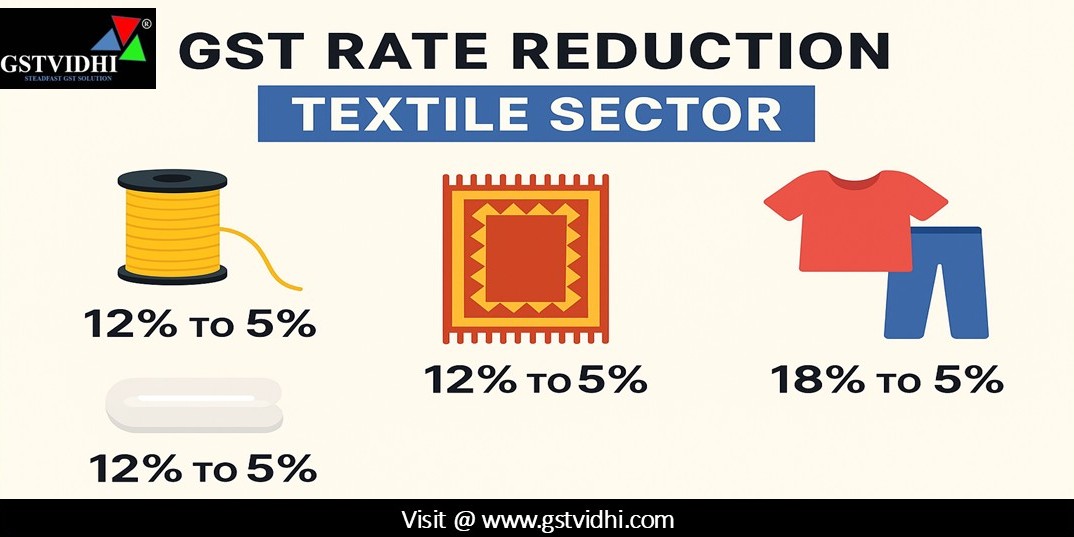
GST Rate Changes in the Textile Sector – 56th GST Council
Meeting
The 56th GST Council
Meeting, held on 3rd September 2025 at Sushma Swaraj Bhavan, New
Delhi under the chairpersonship of Union Finance & Corporate Affairs
Minister Smt. Nirmala Sitharaman, introduced major rationalizations in
the textile sector.
The Council has
recommended significant GST rate changes across yarns, fabrics, floor
coverings, apparel, and made-up articles to boost industry competitiveness,
support MSMEs, and provide relief to consumers.
Key GST
Rate Changes
A. Reduction from 12% to
5%
Applicable to yarns,
sewing threads, wadding, felt, carpets, embroidery, technical textiles, and
certain headgear.
|
S.
No.
|
Chapter
/ Heading
|
Description
of Goods
|
|
1
|
5401
|
Sewing
thread of manmade filaments, whether or not put up for retail sale
|
|
2
|
5402–5406
|
Synthetic
or artificial filament yarns
|
|
3
|
5508
|
Sewing
thread of manmade staple fibres
|
|
4
|
5509–5511
|
Yarn
of manmade staple fibres
|
|
5
|
5601
|
Wadding
of textile materials and articles thereof (e.g., absorbent cotton wool,
except cigarette filter rods)
|
|
6–12
|
5602–5609
|
Felt,
nonwovens, rubberized threads, metallised yarns (excluding zari), gimped
yarns, twine, cordage, ropes, and articles thereof
|
|
13–17
|
5701–5705
|
Various
types of carpets and textile floor coverings (knotted, woven, tufted,
felt-based, and handloom mats/rugs)
|
|
18–27
|
5802–5901
|
Terry
towelling fabrics, gauze, tulles, laces, tapestries, labels, braids, zari
borders, embroidery, quilted products, coated fabrics
|
|
28–37
|
5902–5911
|
Tyre
cord fabric, laminated fabrics, linoleum, wall coverings, rubberized fabrics,
painted canvas, textile hose piping, conveyor belts, and technical textile
products
|
|
38–39
|
6501,
6505
|
Textile
caps; hats (knitted, crocheted, or made up from lace or other fabrics)
|
|
40
|
9404
|
Quilted
textile products not exceeding ₹2500 per piece
|
B. No Change in Rate
(Continues at 5%) – Value-based Relief
|
Chapter
|
Description
|
Condition
|
|
61
|
Knitted/crocheted
apparel & clothing accessories
|
Value
≤ ₹2500 per piece
|
|
62
|
Non-knitted
apparel & clothing accessories
|
Value
≤ ₹2500 per piece
|
|
63
(excl. 63053200, 63053300, 6309)
|
Other
made-up textile articles & sets
|
Value
≤ ₹2500 per piece
|
|
9404
|
Cotton
quilts
|
Value
≤ ₹2500 per piece
|
C. Reduction from 18% to
5%
|
Chapter
|
Description
|
|
5402,
5404, 5406
|
All
goods
|
|
5403,
5405, 5406
|
All
goods
|
|
5501,
5502
|
Synthetic
or artificial filament tow
|
|
5503,
5504, 5506, 5507
|
Synthetic
or artificial staple fibres
|
|
5505
|
Waste
of manmade fibres
|
D. Increase from 12% to
18% (Value > ₹2500 per piece)
|
Chapter
|
Description
|
|
61
|
Knitted/crocheted
apparel & clothing accessories
|
|
62
|
Non-knitted
apparel & clothing accessories
|
|
63
(excl. 6309)
|
Other
made-up textile articles, sets (other than worn clothing, rags)
|
|
9404
|
Cotton
quilts exceeding ₹2500 per piece
|
|
9404
|
Quilted
textile products exceeding ₹2500 per piece
|
Impact of
the Rate Changes
1. Boost
to Domestic Manufacturing – Yarn, filament, and fibres used in
spinning/weaving will become cheaper, reducing input costs for small and medium
textile manufacturers.
2. Consumer
Relief – Everyday textile items like towels, carpets, mats,
and hats will attract a lower rate, making them more affordable.
3. Encouragement
to Handloom & MSME Sector – Handloom rugs, cotton
mats, and zari-related products benefit from rationalized rates.
4. Value-based
Differentiation in Apparel – Low-value garments (≤ ₹2500 per
piece) continue at 5%, while high-value garments (> ₹2500) will now attract
18%, creating a progressive tax structure.
5. Technical
Textiles Growth – Lower GST on conveyor belts, tyre
cords, rubberized fabrics, and other industrial textiles will help the
technical textile segment expand.
Clarifications
(FAQs – Textile Sector Specific)
- Effective Date
– Changes apply from 22nd September 2025.
- Input Tax Credit (ITC)
– ITC is available at the rate applicable at the time of supply;
subsequent rate reductions will not impact credit eligibility.
- High vs. Low Value Garments
– Apparel ≤ ₹2500 remains at 5%, while > ₹2500 will now attract 18%.
- Export Benefit
– Exporters will benefit as input costs reduce due to lower GST on fibres
and yarns.
Conclusion
The GST rate
rationalization in the textile sector is a landmark step to strengthen one
of India’s largest employment-generating industries. By reducing GST from 12%
to 5% on yarns, fibres, carpets, and technical textiles, and rationalizing
apparel rates based on value, the Council has aimed to strike a balance between
industry growth, consumer relief, and revenue needs.
This reform is expected
to energize MSMEs, encourage exports, and make textile products more
affordable for households, while aligning tax rates with global best
practices.
Disclaimer: All the Information is based on the notification, circular advisory and order issued by the Govt. authority and judgement delivered by the court or the authority information is strictly for educational purposes and on the basis of our best understanding of laws & not binding on anyone.
Press On Click Here To Download Order File
Click here